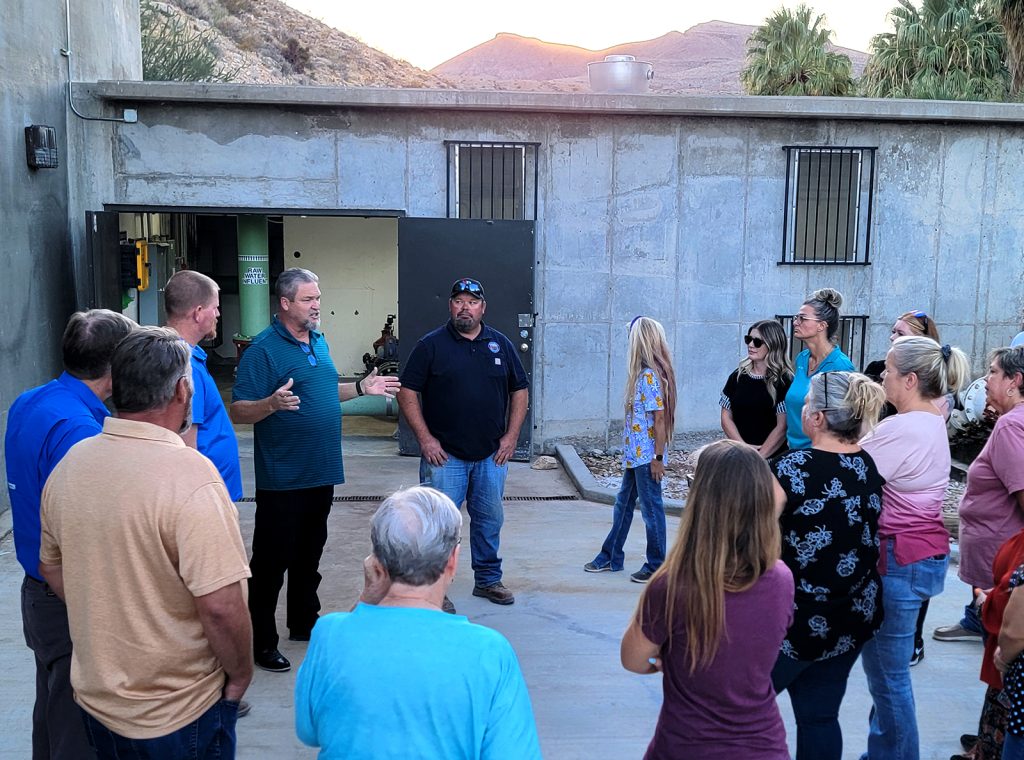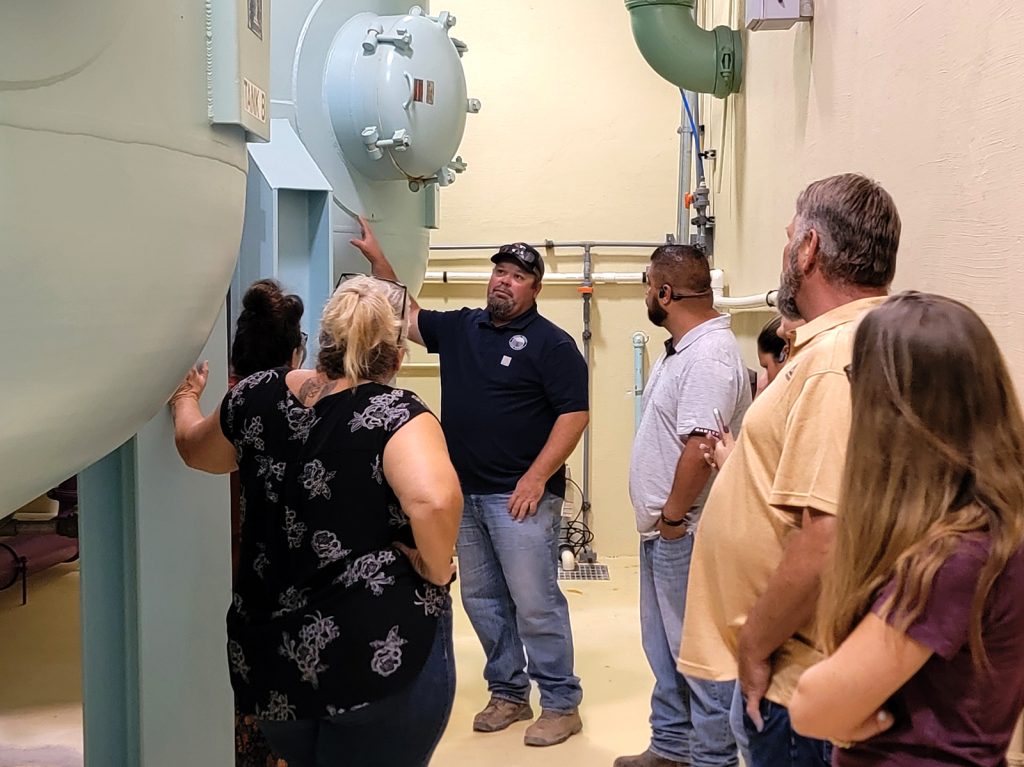
M.V. leaders tour culinary water facilities
About twenty Moapa Valley community leaders gathered at the Moapa Valley Water District (MVWD) office in Overton on Thursday evening, Oct. 3, to set off on a VIP tour of culinary water sources in the community. MVWD hosted the tour in celebration of National Source Water Protection Week which is designated for the first week of October each year.
In attendance were members of the Moapa Valley Town Advisory Board, the Moapa Town Advisory Board, the Moapa Valley Chamber of Commerce board and others.
The two-hour tour took the group about 20 miles north of Overton to the Warm Springs area which is the historical source of water for the Moapa Valley communities.
The first stop was at the district’s Baldwin Springs facility. Here a natural spring flows out of the hillside at about 1,300 gallons per minute (gpm) directly into a concrete holding basin inside of an MVWD building.
Baldwin Springs flows crystal clear from the ground at a warm temperature of about 87 degrees. From the holding basin the water is directed into a piped system, receives minimal treatment for naturally-occurring arsenic levels, and is injected with a little chlorine before being pumped to the 3-million-gallon storage tank in Moapa for distribution to local homes and businesses.
The second stop was at the MVWD Arrow Canyon well site, also located nearby. Here the district operates two separate production wells. Arrow Canyon #1, the older of the two, is at a depth of 570 feet and produces up to 4,500 gpm. It has been the primary source for the district for more than 30 years. The lesser producing Arrow Canyon #2 goes down to a depth of 750 feet and produces up to about 1,400 gpm.
“It is always amazing to me the pristine source of our water here in the valley,” said MVWD General Manager Joe Davis. “We are fortunate enough to have our own local water source so that we don’t have to rely on water that is sourced from somewhere else. We as a community need to be careful that we protect these precious resources.”
For example, Davis pointed out that there are more than 70 older wells throughout the Moapa Valley that are still open, but are not being used or maintained. “Those could be a source of a problem for the underground aquifer if contaminants end up in those wells,” Davis said. “Those things need to be taken care of.”
The district has also been part of agreements and alliances with other regional entities in protecting and preserving the Warm Springs area including not only it’s water resources, but also its natural habitat for wildlife, Davis said.
MVWD serviceman Mica Leatham led the tour explaining that the district’s water production facilities are maintained, operated and controlled by local crews only.
Leatham led the group through the district’s arsenic treatment facilities located at both sites. These large buildings are filled with huge steel vessels where water passes through a rust-like media to remove the arsenic content.
The treatment facilities were brought online back in 2009 shortly after a federal regulation adopted new standards for arsenic in drinking water. At that time, the threshold was dropped from 25 parts per billion (ppb) to only 10 ppb. The MVWD water sources were measured at 14 ppb, just above the new threshold.
The district was thus required to construct the two treatment plants at a cost of $5.5 million. This caused rate increases of 18 percent over two consecutive years in the early 2000s.
The tour also included information on the emergency preparedness efforts made by the district. Leatham talked about the huge diesel generators acquired by the district; one placed at each site. These are enough to power all of the production needs for each facility for about 6 days straight, he said.
“It was the big Warm Springs wildfire in 2010 that started the idea of needing to have our own generation capabilities,” Leatham said. “We were without power for a time during the fire. So we have placed generators here so that we can keep pumping water even during a power outage.”
One of the participants asked how long it would take to repair a break in the system that was big enough to cause a general loss of service. MVWD officials responded that it would take about half of a day.
But Davis added that there should be adequate storage capacity in the MVWD tanks – currently consisting of more than 8 million gallons – to get the community through most such situations.
That is, unless the public begins to panic, he said.
“In 2014 when that big flood washed out the I-15, our system was hit pretty hard,” Davis said. “Even so, we should have had plenty of water in storage to give us ample time to make repairs.”
But just then a rumor went out in the community that water service might be interrupted. Many people began hoarding water in their sinks, bathtubs, tanks etc., Davis said.
“The water levels in our tanks dropped like a rock,” he said. “It was pretty concerning at the time. By the time we got things back online, we were within only about 2 feet in the tank from running out of water to the community. It was that close, and it really didn’t need to be that way.”
Davis said that he is puzzled to this day what happened to all that water. “With that much water going out, we should have seen rice paddies popping up throughout the valley,” he joked.
Davis emphasized that if residents want to stockpile stores of water, they should do so well before any emergency; not during. Hoarding water in the middle of an emergency can only cause more problems, he said.
“The 8 million gallons of water in our tanks is there to get us through in time of an emergency,” Davis said. “The district has invested a lot to make sure that is in place. So during an emergency, if everyone will stay calm and just stick to their normal water usage, we should have more than enough to get us all through until the problems get fixed.”


